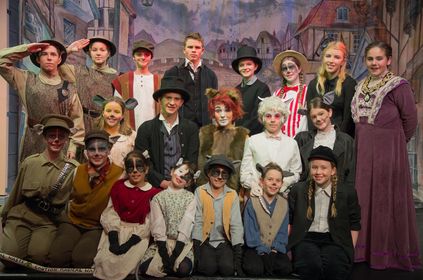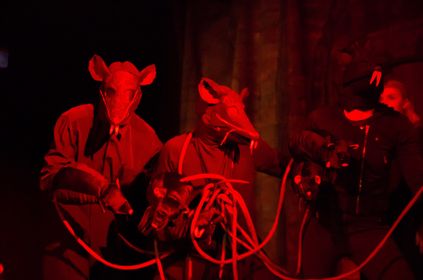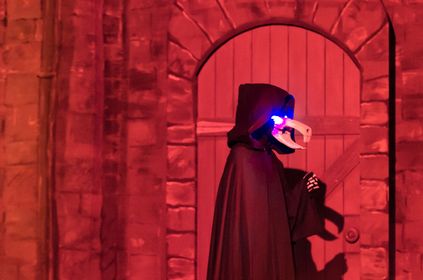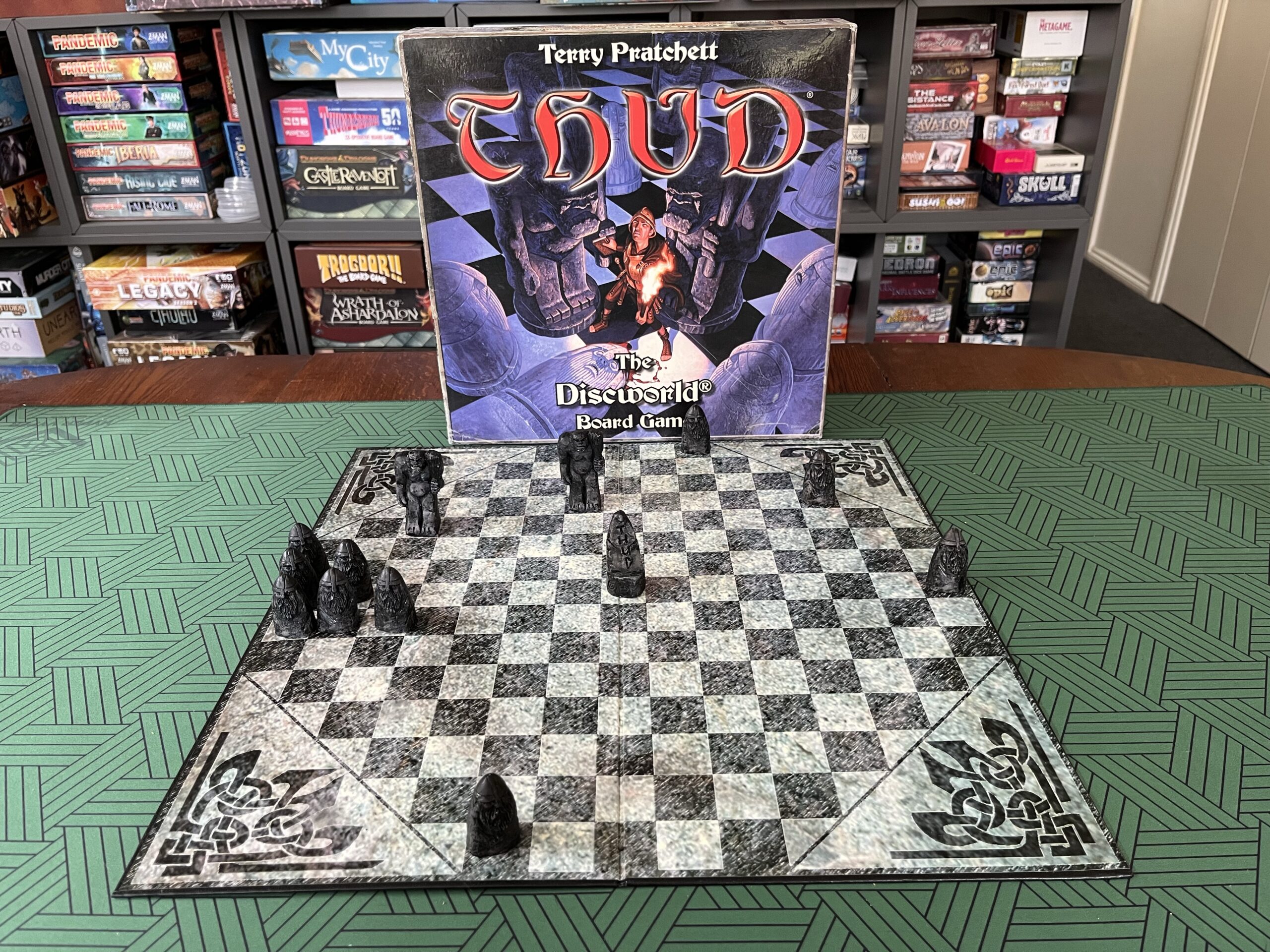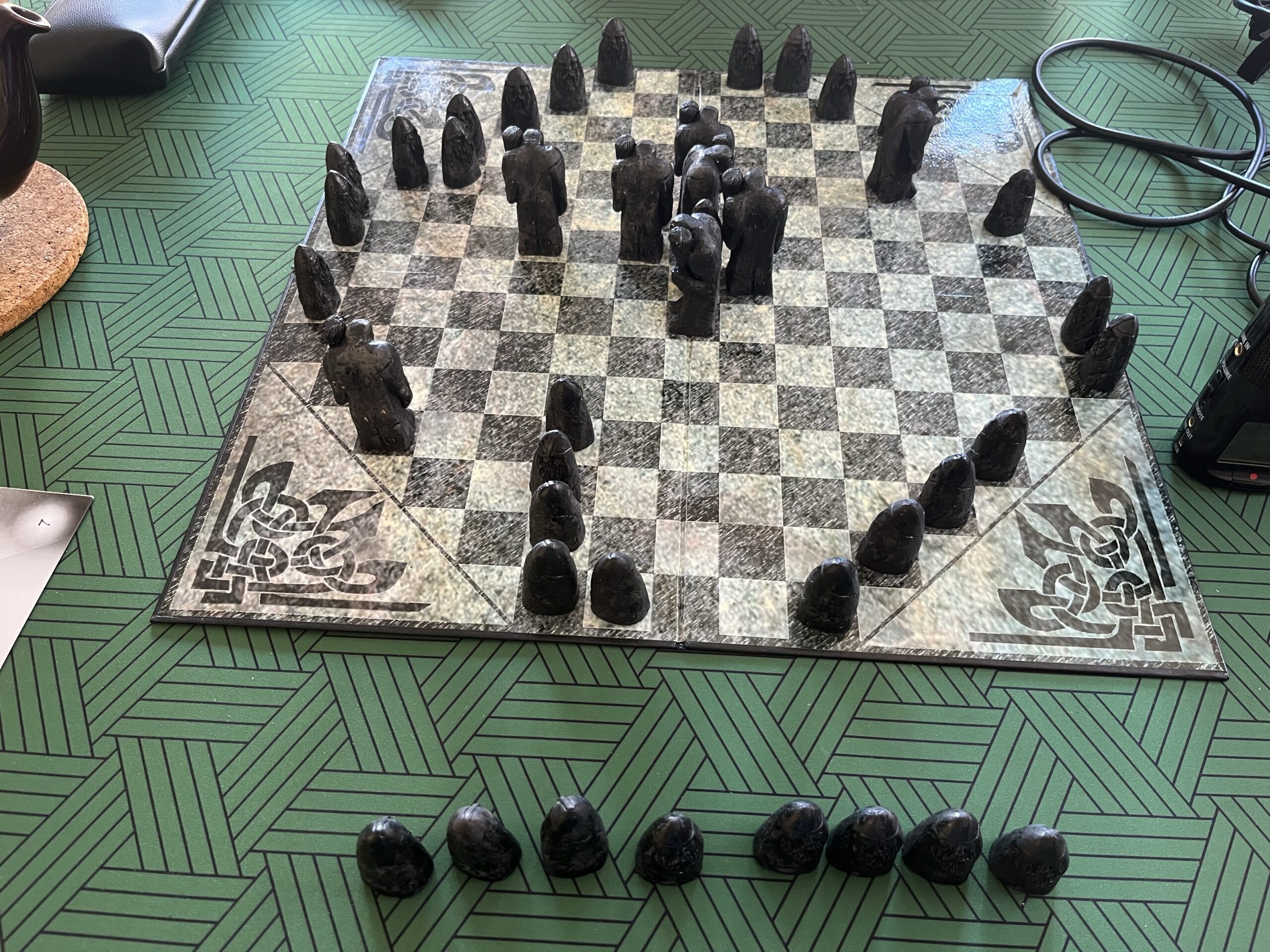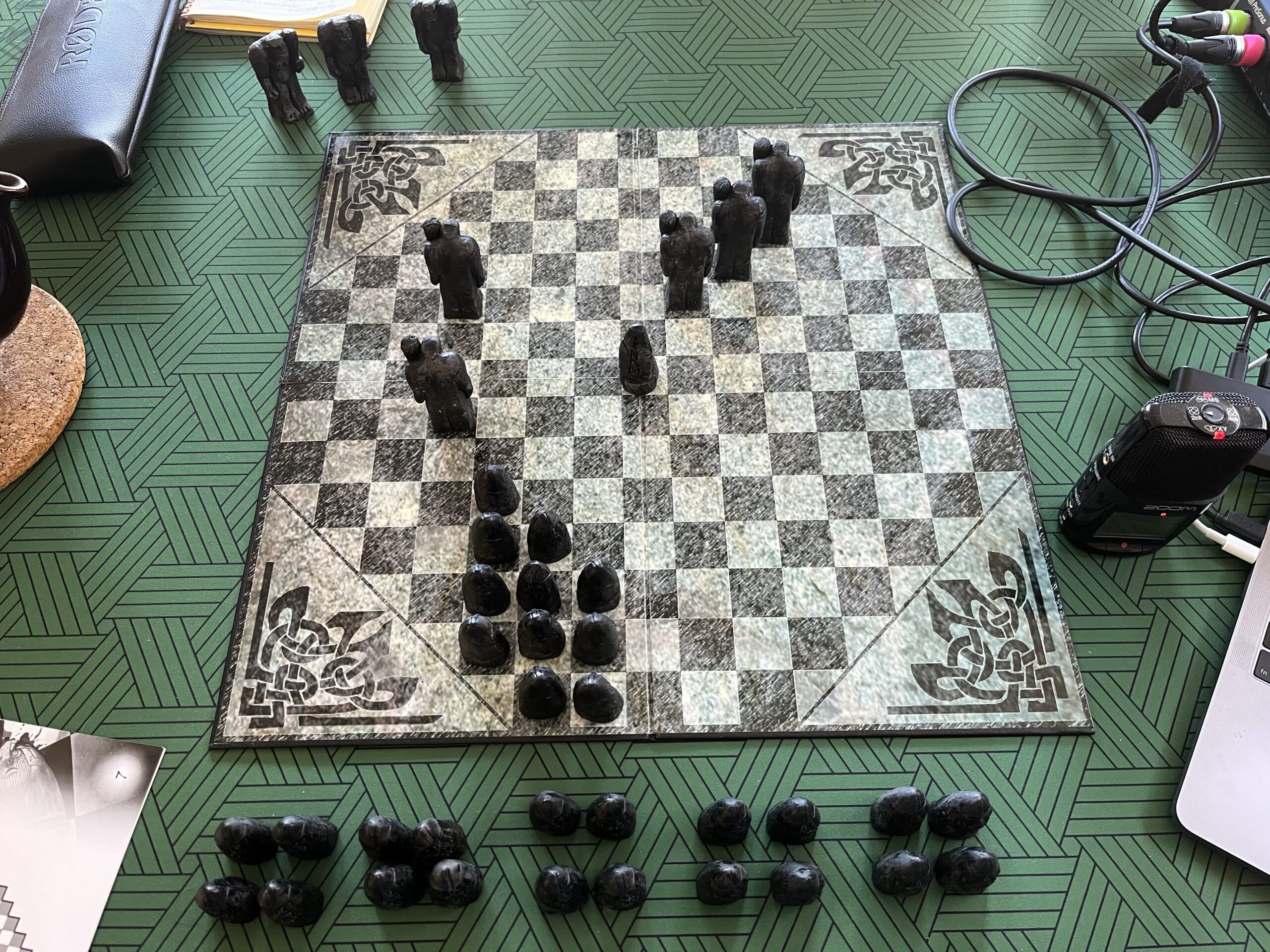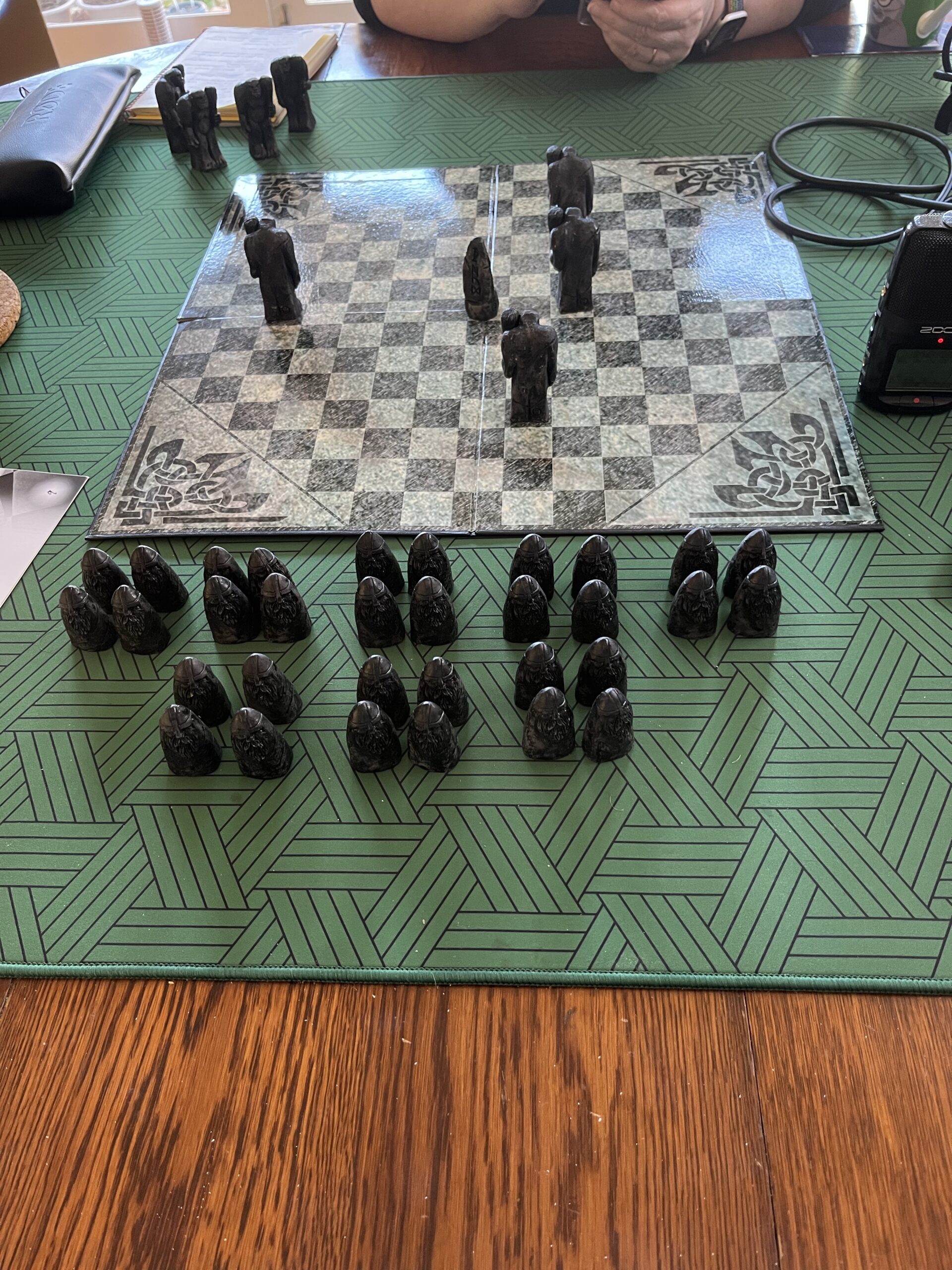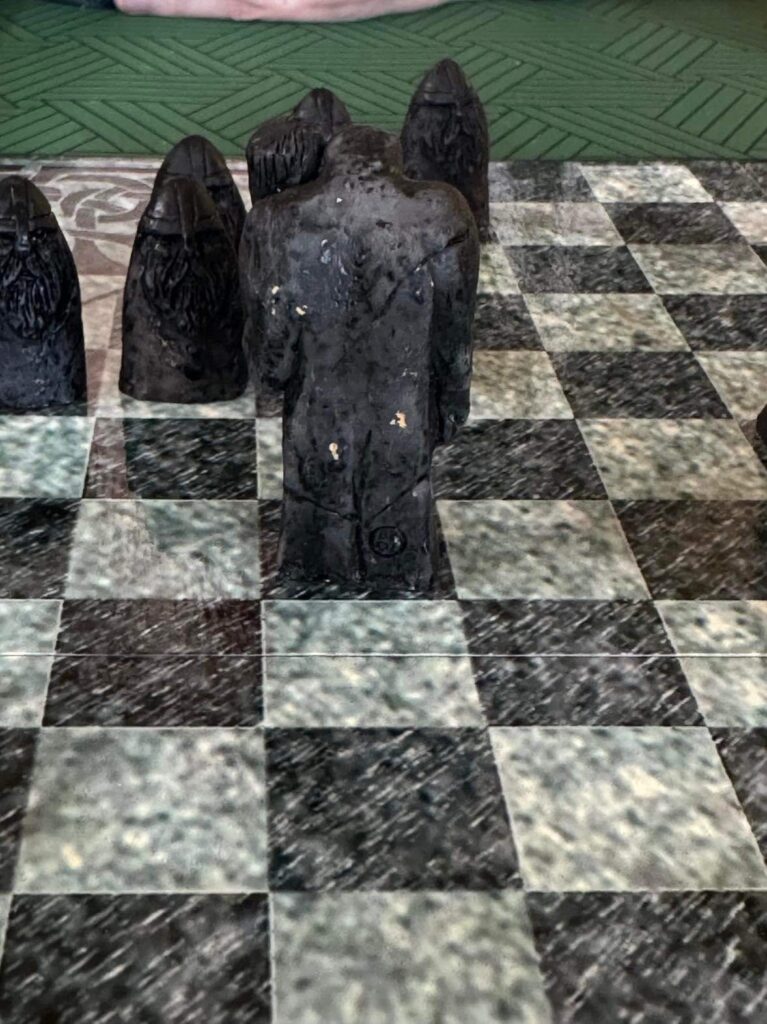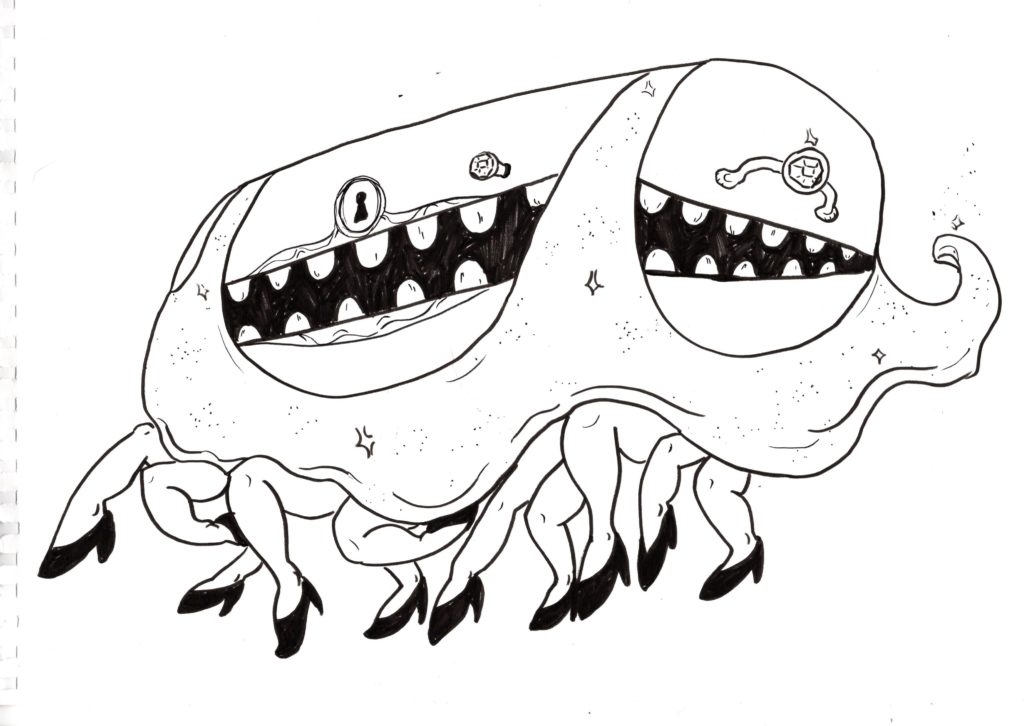#Pratchat48 Notes and Errata
These are the episode notes and errata for episode 48, “Lu-Tze in the Sky with Lobsang”, featuring guest Benjamin Riley, discussing the 26th Discworld novel: 2001’s Thief of Time.
(To avoid any confusion, in these notes we’ve referred to our guest this episode as “Guest Ben”, and our co-host as “our Ben”, which has the delightful side effect of making it sound like he’s part of the Ogg clan.)
- The episode title is a riff on the Beatles song “Lucy in the Sky with Diamonds”, featured on their 1967 concept album Sgt. Pepper’s Lonely Hearts Club Band. While long rumoured to be about hallucinations brought on by the use of psychotropic drugs – in large part because the title coincidentally includes the acronym LSD – it was actually inspired by an illustration made by John’s young son, Julian Lennon, which he described using the phrase.
- Guest Ben and Liz used to have “Time Travel Wednesdays” when they worked together, but our Ben’s brain immediately time travels to Tuesdays, presumably for the sake of alliteration. We apologise for any confusion caused.
- Craig Hildebrand-Burke was indeed our guest when we discussed Jingo back in #Pratchat27, “Leshp Miserablés“. (This is one we’d like to revisit with a bit more sensitivity to some things in our blindspot last time.)
- Guest Ben’s favourite Discworld period (which he points out is the same as previous guest Craig’s) runs from Jingo (the twenty-first Discworld novel, published in November 1997; see #Pratchat27) to Thud (the thirty-fourth, published in September 2005; probably coming in 2022). This period also includes the first three Science of Discworld books, the first three younger readers books (The Amazing Maurice and the first two Tiffany Aching books), and the introduction of Moist von Lipwig in Going Postal. It’s also notable that Pratchett didn’t publish any non-Discworld books during this period. (Our Ben feels that thematically and tonally this run begins slightly earlier, with either Maskerade or Feet of Clay, meaning it also includes Hogfather.)
- Cigars are most associated with His Grace Sir Samuel Vimes, Commander of the Watch and Duke of Ankh, though in Guards! Guards!, when he was still just the low-paid Captain of the disregarded Night Watch, he rolls his own cigarettes. By Men at Arms he has moved on to “cheap” cigars, and in Feet of Clay “thin” ones which he carries in a case (or at least he did until Nobby stole the case). He sometimes lights them using swamp dragons, a habit which annoys Sybil. He’s not the only cigar smoker; Nobby is plied with cigars in Feet of Clay, and Nanny Ogg also indulges, though this is only seen briefly in Wyrd Sisters when she’s also drinking in the pub.
- “That X-Men movie that fixes that crap X-Men movie” is X-Men: Days of Future Past (2014; dir. Bryan Singer), a film adaptation of the epic comic book time travel story which turned the intended reboot film X-Men: First Class (2011; dir. Matthew Vaughn) into a prequel of the original X-Men movie trilogy. The film opens in a future in which mutants have been hunted nearly to extinction, so Wolverine (Hugh Jackman) is psychically sent back in time to prevent the murder which sent history down that leg of the trousers of time. He is successful, and when he returns to the present, the timeline resembles that of the original trilogy – except that the events of the near-universally hated X-Men: The Last Stand (2006, dir. Brett Ratner) haven’t happened, as quickly established by the inclusion of characters either only appearing or killed off in that film.
- The idea of the white face and the red nose – named after two styles of clown makeup, and expounded upon in Eric Idle’s sci-fi novel The Road to Mars – is a characterisation of comedic duos in which one, the “white face”, is serious and has (or assumes) a higher level or importance than the other, the buffoon or “red nose”. As well as the obvious surface level, comedy is often derived from the red nose puncturing the white face’s pompous attitude. Colon and Nobby are in some ways the archetypal Discworld example, but there are many others. In theatre terms, the white face is said to be a “high status” character, while the red nose is “low status”.
- There are two kinds of big wheel that circus performers roll around in, but the one our Ben is thinking of is a German wheel: two big metal hoops connected by metal struts with stirrups and handholds. They were invented for – and are still used in – gymnastics. (The other kind of circus wheel is a single metal hoop called a Cyr wheel.)
- Wallace and Gromit are the stop-motion animated stars several short and feature films, created by Nick Park of Aardman Animations. Wallace (voiced primarily by Peter Sallis) is a well-meaning, eccentric and talented inventor with a passion for cheese, while Gromit is his supremely competent and loyal dog. The success of their first film, 1989’s A Grand Day Out, led to several sequels and spin-offs, including the television and film series Shaun the Sheep.
- We’re afraid you’ll have to get used to the term “timey-wimey” during this episode, since it just feels so apt for a book with little in the way of actual time travel, but much in the way of time-related weirdness. Its origin is Doctor Who, specifically the Tenth Doctor’s explanation of causality in the third season episode “Blink”. We gave the full quote in our notes for #Pratchat35, but here we’ll add that in the fiftieth anniversary special The Day of the Doctor, when the Eleventh Doctor uses the phrase and the War Doctor (an earlier, grumpier incarnation) finds it preposterous, the Tenth Doctor pretends he’s never heard it.
- Jeremy Clarkson started out as a journalist, but is best known now as a television personality. He was one of many hosts of the original version of Top Gear, the BBC Two motoring show which ran from 1977 to 2001, and after it was cancelled devised a new format for the show which debuted in 2002 – the year after Thief of Time was published, so he was considerably less famous then (though still pretty well-known in the UK). He was one of the new version’s original hosts, alongside Richard Hammond; they were joined by James May from the second series and remained the main hosting team for over a decade. Even before the new Top Gear, Clarkson attracted criticism for making bigoted remarks, but these only increased in frequency as he grew more famous, with a series of controversies over comments on- and off-air that ran the gamut of anti-environmentalism, sexism, homophobia, ableism and racism. (There’s an entire Wikipedia page dedicated to controversies on Top Gear, most of them involving Clarkson.) Clarkson generally dismisses these criticisms, but also seems to court controversy deliberately to increase his fame, stating on multiple occasions that he may not believe all the things he says. By 2014, however, he was on a “final warning” from the BBC, and in 2015, after he verbally abused and then physically assaulted one of the show’s producers while on location (ostensibly because he wasn’t served the meal he wanted), the BBC cut the show’s season short and declined to renew Clarkson’s contract, despite a petition from fans with a million signatures. Hammond and May left the show with him, which continued with various new presenters, including Friends and Episodes star Matt leBlanc. Clarkson’s new show with Hammond and May, The Grand Tour, was basically Top Gear in all but name, and began on Amazon Prime in 2016, where he now also hosts Clarkson’s Farm, a show about the farm he owns in the Cotswolds, not far from Pratchett’s home in Wiltshire. He’s still very famous in the UK, where he has hosted their version of Who Wants to Be a Millionaire? since 2018 and makes various other television appearances – though not on the BBC.
- Lobsang is a favourite name of Pratchett’s, used most prominently here and as the name of a major character in The Long Earth books, though it crops up many times in the novels. The earliest Lobsang is the Abbott Mort deals with on his first solo round as Death in Mort, though his name is only mentioned once – the rest of the time he’s just “the Abbott” – so don’t feel bad if you missed it. Another early appearance is near the end of Guards! Guards! (See also the note below about knowledge coming from a long way away.) The name is a fairly specific reference to “Dr Tuesday Lobsang Rampa”, author of several books about the spiritual and paranormal, most famously The Third Eye in 1956. He was later revealed to be Cyril Henry Hoskin, a plumber from Devon. For more on his weird story, listen to our discussion of The Long Earth in #Pratchat31, “It’s Just a Step to the West“, or look him up yourself; you’ll be amazed.
- The tick of the Universe more or less exists in the real world in the concept of Planck time, the “briefest physically meaningful span of time”, which is about 5.39×10−44 seconds. According to an article from 2020, the briefest time so far measured is 247 zeptoseconds (or 10-21 seconds), so even the most accurate atomic clocks can’t duplicate Jeremy’s feat. (Assuming the same length of tick in Discworld space is dubious, but if true, the glass clock is approximately 10,000,000,000,000,000,000,000 times more accurate than the best atomic clock.)
- Susan Sto-Helit is the daughter of the Duke and Duchess of Sto-Helit – Death’s one-time apprentice Mort and adopted daughter Ysabell. Their story is told in the fourth Discworld novel, Mort (see #Pratchat2), while Susan first appeared as a teenager in Soul Music (#Pratchat19) before returning at more-or-less the same age she is here in Hogfather (#Pratchat26). In the animated Soul Music she was voiced by Debra J Gillet (who also provided the voice of Grimma in the stop-motion version of Truckers), and in the live-action adaptation of Hogfather, she was played by Michelle Dockery (now best known for her starring role as Lady Mary Crawley in Downton Abbey).
- Montessori and Steiner schools are two different alternative models for educating children and young people.
- Montessori education, developed by Italian doctor and educator Maria Montessori (1870-1952) around the turn of the twentieth century, focuses on self-directed learning based on natural human development. Its basis is that children naturally want to learn, but formal education prevents them from doing so in the way that’s best for them; Montessori schools are usually primary schools and allow students to pursue the activities and subjects they find most interesting, usually through playful means. Many aspects of Montessori’s work have been adopted into mainstream teaching as well.
- Steiner education, also known as Waldorf education, is based on the work of Rudolph Steiner (1861-1925), an Austrian philosopher (among many other things). Steiner’s “anthroposophy” teaches that humans can better understand the spiritual world through personal development, though the spiritual aspects of the philosophy are not always emphasised in Steiner education. Its main focus is holistic teaching, believing that students will do best if they develop their intellectual skills alongside artistic and practical ones. Steiner schools use a developmental model that runs from infancy through to secondary education, and have become increasingly popular; they are now the largest independent educational movement in the world, and have forty-five schools across Australia.
- Professor Valerie Felicity Frizzle, PhD, originally known as Ms Frizzle or “the Frizz”, is the teacher in The Magic School Bus books by Joanna Cole, later developed into television series and videogames. The titular bus could travel safely to just about anywhere in time and space, allowing Ms Frizzle to teach her students about various scientific concepts. Cole died in 2020, the year a Netflix continuation, The Magic School Bus Rides Again, debuted. In the sequel, the original Ms Frizzle gets her doctorate and passes the school bus on to her younger sister, Miss Fiona Felicity Frizzle. In both the television and Netflix series, Valerie Frizzle is played by Lily Tomlin; Fiona was played by Kate McKinnon (of Saturday Night Live and Ghostbusters fame).
- Lu-Tze and the History Monks first appear in 1992’s Small Gods (discussed in #Pratchat16, “He Ain’t Heavy, He’s My Vorbis“). They are described as the caretakers of history, keepers of the “the books from which history is derived”. Lu-Tze is sent by the 493rd Abbot – the same one recently reincarnated in this book – to Omnia, where “things must be…carefully observed“. Lu-Tze mentions in Small Gods that he hasn’t been to Omnia in seven hundred years, which almost agrees with his age of eight hundred in this book, set about a century later. By the end of that book he has “patched up” history such that Brutha does not die, avoiding a century of terrible warfare; Brutha instead lives for most of the intervening century and reforms Omnianism. This suggests Lu-Tze’s mission to Omnia was one of the things that needed fixing as a result of the first glass clock; Igors are long-lived enough that this Igor’s grandfather could certainly have built the previous clock a century earlier, though it also seems that the History Monks are able to leave their valley at just about any point in history they choose. Lu-Tze will return in Night Watch.
- Lu-Tze’s name is derived from Loazi (老子), author of the Tao Te Ching and founder of Taoism, who lived in the 6th century BCE. Loazi – also romanised as Lao Tze or Loa Tzu – is actually an honorific title meaning “venerable master”, and there is some debate about who he was, or even if such a single person truly existed, or was just a pen name for multiple authors of the Tao Te Ching. Listener Felix let us known that Lu-Tze might be an intentional bilingual pun, as Lǔ is a Mandarin word meaning “foolish” or “crude”, making Lu-Tze a “Foolish/Crude Master”.
- While we may not have been able to spot many references to specific kung fu movies, there’s at least one clear reference to the 1972 American TV series Kung Fu. When Lu-Tze takes on Lobsang as an apprentice, he tells him: ‘Word One is, you don’t call me “master” and I don’t name you after some damn insect.’ In Kung Fu, the main character Caine – played by white American actor David Carradine, who was cast over a host of potential Asian American actors, including Bruce Lee – is a Shaolin monk wandering the Old West looking for his brother. In flashbacks to his training, he refers to he teacher as “Master”, who calls Caine “Grasshopper”.
- We previously talked about The Karate Kid (1984, dir. John G Avildsen) in #Pratchat25, “Eskist Attitudes“. Mr Miyagi is the elderly Japanese neighbour of Danny LaRusso, who asks him to teach him karate so he can protect himself from the bullies at his new school. Miyagi sets Danny chores which are revealed to have taught him some basic movements essential to karate.
- We’ve not yet nailed down which kung fu movie with the famous moving shot Liz is thinking about; suffice to say it’s not called The Tenth Dojo. If you know the one, please get in touch!
- If you want to get a handle on the history of martial arts films, The Conversation recently published a great article by Joyleen Christensen: “From Bruce Lee to Shang-Chi: a short history of the Kung Fu film in cinema”.
- Speaking of kung fu cinema, one of the many things that inspired George Lucas’ Star Wars was the Master-Apprentice relationship in such films. Thus Jedi ideally begin training at a young age, and when they reach the rank of “Padawan” they are apprenticed to a Jedi Master, travelling with them and learning from them until the Jedi Council deems them worthy of the rank of Jedi Knight, at which point they have finished their apprenticeship.
- The previous joke about people thinking wisdom has to come from far away appears in Witches Abroad (see #Pratchat12), where Magrat is reading The Path of the Scorpion, a book of which she is suspicious partly because the author – “Grand Master Lobsang Dibbler” – has an address in Ankh-Morpork. (The author is clearly CMOT Dibbler, leading us to wonder why the name “Lobsang” is apparently well-known on the Disc – and why Newgate Ludd ends up with it…) The full quote of the joke appears below (though see also the following note):
It’s a strange thing about determined seekers-after-wisdom that, no matter where they happen to be, they’ll always seek wisdom which is a long way off. Wisdom is one of the few things that looks bigger the further away it is.*
Terry Pratchett, Witches Abroad (1991)
- Mrs Marietta Cosmopolite appears in Moving Pictures, where she is a “little old lady” seamstress in Ankh-Morpork who becomes a costume designer in Holy Wood for Century of the Fruitbat Moving Pictures. She is also mentioned in the footnote to the quote above from Witches Abroad, which contains the first appearance of The Way of Mrs Cosmopolite, in which monks travel from the Hub mountains to hear her wisdom, though they can’t understand her. It would seem Lu-Tze was the first of these monks, since by the time others come to visit her she is hitting them with a broom and telling them to push off, rather than taking them in as lodgers. Her address is consistently given in all the books as 3 Quirm Street, an unusually specific bit of continuity that leads us to wonder if she is an obscure reference of some sort? (Despite that attention to detail, her surname is spelt “Cosmopolite” in all the books except Thief of Time, where its spelt “Cosmopilite”; the reasons for this are a mystery.)
- Slaughterhouse-Five is Kurt Vonnegut’s 1969 anti-war novel, in which protagonist Billy Pilgrim is “unstuck in time”, and thus experiences his life somewhat out of order. We previously discussed it in #Pratchat26. A film adaptation was made in 1972; Vonnegut was very happy with it.
- Monstrous Regiment is the thirty-first Discworld novel, published in 2003. We’ll cover it in a future episode, but listener Steavie urged Guest Ben (and the rest of us) to listen to Pratchett’s interview for the Wheeler Centre in 2014 (now available only YouTube), which we previously linked to in #Pratchat26 when the interviewer, Michael Williams, was our guest. Pratchett talks (from around the 31:30 mark) about researching the history of women fighting and living as men at “a nice little place in London run by ladies who like other ladies very much indeed”. (In The Magic of Terry Pratchett, Marc Burrows identifies this research as taking place in “queer-focussed bookshops”, though no specific ones are named.) This seems a pretty good indication that he knew what he was writing, at least on some level.
- The gay character in Unseen Academicals, Pepe the dwarf fashion designer, was quite definitely intended by Pratchett to be gay; in the same 2014 interview linked above, Pratchett describes Pepe being “as gay as a tree full of monkeys”. (The question and answer where he says this starts at around 16m30s.)
- Of course there’s no way for us to know if Pratchett had many out gay friends, but he certainly met a great number of queer and trans fans, many of whom have shared stories via social media that show him to have been kind and empathetic towards them.
- Many of the stories from the note above were reported in response to the “gender critical” incident, which we won’t give too much oxygen. (If you need some background on what “trans” means, guest Fury gives a little 101 in #Pratchat29.) The short version is that a couple of vocal anti-trans commentators, angry that Maragret Atwood had identified herself as a trans ally, got fed up with Neil Gaiman also being clearly pro-trans. So they suggested on Twitter that Terry Pratchett was more “acquainted with reality” than Gaiman and that the Witches books showed Pratchett knew “what female is and means in the world”. Twitter’s considerable number of Terry fans – including his daughter Rhianna – of course found this absurd, given the way he writes about gender roles in books like Equal Rites, Feet of Clay, The Fifth Elephant and Monstrous Regiment. That didn’t stop commentators claiming that we “couldn’t know” what he thinks as he wasn’t around to ask…though we reckon his closest friends and family might have a pretty good idea?
- The idea of consensual reality is that the universe conforms to people’s beliefs. Wikiality is sort of the opposite idea – that people have a common idea of what’s true that might not align with objective reality. The word was coined by Stephen Colbert on the July 6, 2006 episode of his satirical show The Colbert Report; his right-wing persona, in his “The Wørd” segment, praised Wikipedia for being editable, meaning that it could be changed to reflect “truthiness”, Colbert’s parody of terms used by conservative politicians to deny facts they found inconvenient. He defined the word “wikiality” to mean “truth by consensus”, and encouraged his viewers to edit Wikipedia to change “facts”, making people believe things that weren’t true. This resulted in a whole thing where people edited multiple articles on Wikipedia to suggest the world’s elephant population had tripled…
- We’ve previously mentioned alt.fan.pratchett, the newsgroup from the 1990s where Pratchett occasionally answered fan questions; see the notes for #Pratchat42 for more information.
- Listener Vlad pointed out to us that there is indeed an aviator on the Discworld – Hamish, of the Nac Mac Feegle, is referred to as “Hamish the aviator” by Tiffany in Chapter 7 of The Wee Free Men (see #Pratchat32). While Tiffany presumably learned the word from her cover-to-cover read of the dictionary, in our Ben’s defence, it’s a bit weird that it’s in the dictionary if it’s a term invented by or for the Feegles – though as it comes from the same root word as “Avian”, it certainly makes sense for Hamish to use it, since he does his flying on birds! (We’ve since realised that this also applies to Corporal Buggy Swires, gnome recruit in the Ankh-Morpork City Watch, who rides a heron in Night Watch.) All that said, in the same chapter Tiffany tells Hamish about a paratrooper toy she had as a younger child, so perhaps we just have to accept that things which were singular oddities before powered flight on Roundworld have somehow gained enough notice to become talked of frequently and affect language on the Disc…
- Despite it being generally believed that he did, Terry did not cover nuclear reactors as a journalist; a case of wikiality in action! As Marc Burrows clarifies in his biography The Magic of Terry Pratchett, Terry quit journalism in 1979 (before he sold his first big novel) and took a job – mostly for the money – in public relations, specifically for the South-West office of the Central Electricity Generating Board (or CEGB). The job wasn’t meant to revolve around nuclear power, but the infamous partial meltdown at Three Mile Island in the US – causing the evacuation of 140,000 people – happened three weeks before he started, and the region covered by his office of the CEGB included three of Britain’s nuclear power plants. So of course he spent most of his time responding to public and media fears of meltdowns.
- Lifetimers, mentioned only in passing in this book, are the hourglass-like devices which Death uses to determine when people on the Disc will die. Everyone has one, even the gods and – in Reaper Man at least – Death himself. While Death doesn’t always seem to need one – they’re not often referred to in his cameos to collect souls – Mort is taught to take with him the lifetimers of those he needs to visit in Mort, so our speculation that they’re required might be correct. (Death clearly has somewhere in his robe where he can hide them…)
- Q – with the help of his department, Q Branch – is the boffin responsible for James Bond’s famous gadgets, like the car that could turn into a submarine, various watches with electromagnets, lasers and knockout gas, and a tiny rocket launcher disguised as a cigarette (no really) – plus of course dozens of different things that could explode. The character’s codename is short for “Quartermaster”, a military term which in the army refers to a senior soldier in charge of equipment and supplies. Q is mentioned but never appears in the original novels; the closest equivalent is Major Boothroyd, an armourer who appears in Dr. No, the sixth novel. Desmond Llewellyn appeared as Boothroyd in the film version of Dr. No, and the producers decided to keep him on as Q in subsequent films, merging the two characters together (or at least making audiences think they’re the same person). Llewellyn’s Q appears in seventeen of the Bond films, in scenes where he would show off gadgets to Bond and often have to remark “Oh do pay attention, 007”. He announced his plans to retire in 1999’s The World is Not Enough, which also introduced his assistant “R”, played by John Cleese, who took over as Q in the following film, 2002’s Die Another Day. The Daniel Craig Bond films feature a new younger Q, played by Ben Wishaw, who appears in Skyfall, Spectre and No Time to Die.
- Desmond Llewellyn died in a car accident in December 1999, a few weeks after the release of The World is Not Enough, while on his way to a book signing. Thief of Time was published about eighteen months later, in May 2001, so Pratchett may have started writing it while Llewellyn was still alive. Terry’s quote on the matter from the Annotated Pratchett File is: “As I wrote it I could [hear Llewellyn’s voice], too. Qu will be back — unlike, alas, Desmond Llewellyn.” (Qu did come back, in Night Watch.)
- The boffin with the exploding gadgets in Night Terrace – the time travel radio comedy co-produced, co-written and co-starring Ben – is Horatio Gray (played by The Chaser’s Andrew Hansen). He appears primarily in the second season episode “The Retirement of Horatio Gray”, and is the creation of Night Terrace co-creator Lee Zachariah. (You can find out more about the show at nightterrace.com.)
- Guest Ben’s summary of the theory of relativity is pretty much spot on: special relativity was Einstein’s explanation for the speed of light, which had been observed in experiments to always be the same, even under conditions where you’d expect it to be different. The theory tells us that time and distance are not fixed, but are relative, in the same way we already though of motion as being relative. “History” – in this case, our personal perception of time – has to “give” to keep the speed of light constant in those circumstances. (General relativity, which came later, explained how special relativity interacted with gravity by combining space and time into a single set of dimensions we now know as “spacetime”. It describes gravity as a curving of spacetime near massive objects.) Of note is that the idea of time and distance being relative had already been worked out mathematically by Hendrik Lorentz, a Dutch physicist, ten years before Einstein, but he thought this was an abstract mathematical model, not a description of the way the physical universe worked. (This is why the equations involved in translating time and location information between frames of reference – between you on the surface of the Earth and a satellite in orbit, for example – are called Lorentz transformations.)
- We’ve previously talked about Pratchett’s love of videogames in #Pratchat28 (about Only You Can Save Mankind) and #Pratchat36 (about Carpe Jugulum, which includes a pretty blatant reference to Tomb Raider). Of note: he was a big fan of roleplaying games too; his special favourite for a long time was The Elder Scrolls IV: Oblivion, largely because of the modding community of fans who create “mods” (modifications) that add in extra stuff, like being able to make a living from crafting, more realistic weather, even rainbows. You can read an out-take from a radio interview where he talked about this stuff on The Author Hour in 2009.
- “Man not of woman born” is a reference to Shakespeare’s Macbeth, in which Lord Macbeth is given a prophecy by three witches that “none of woman born / Shall harm Macbeth”. It later turns out that Macduff was “from his mother’s womb / Untimely ripped” – i.e. born via Caesarean section – which apparently doesn’t count as being “of woman born”. Bit of a long bow, if you ask us. Probably a closer analogue to what we were talking about was the prophecy in The Lord of the Rings, in which it is said of the mighty Witch-king, the Lord of the Nazgūl (the Ring-wraiths who serve Sauron), that “not by the hand of man shall he fall”. He ends up being killed instead by Merry (a hobbit) and Éowyn (a woman) at the Battle of Pelennor Fields. (This is the big fight between orcs and men at the city of Minas Tirith; it appears in the third book and film, The Return of the King.)
- Reservoir Dogs (1992) was the first feature film written and directed by Quentin Tarantino. In the film, six men participating in a bank heist refer to each other only by the pseudonyms Mr. Brown, Mr. White, Mr. Blonde, Mr. Blue, Mr. Orange and Mr. Pink. In the scene where they get their aliases, they argue about the allocation of names, which are given out by the organiser. (Content warning for the clip: it’s not gentle language, and the crims are casually homophobic.)
- Guest Ben talks about Steven Moffat’s Doctor Who, likening the incarnated Auditors to monsters from his era (perhaps the Whispermen from The Name of the Doctor), and the time in the museum to the the end of Matt Smith’s first season – The Pandorica Opens/The Big Bang.
- Was Pratchett a Doctor Who fan? Not really…though he did enjoy the show. Writing for SFX magazine in 2010, he complained that it “breaks most of the laws of narrative”, and he derided the modern show as being powered by “makeitupasyougoalongeum”, a sentiment he repeated when writing the introduction to Behind the Sofa, a 2012 collection of celebrity reminiscences about the program published to raise money for Alzheimers research. (It was updated and expanded in 2013.) He did confess, in the SFX article, that despite his misgivings he continued to watch: “After all, when you’ve had your moan you have to admit that it is very, very entertaining, with its heart in the right place, even if its head is often in orbit around Jupiter.” (You can find some excerpts from the SFX article in this piece at The Guardian; Behind the Sofa is still available as an eBook.)
- Both Death and the Doctor having a granddaughter named Susan is likely a deliberate decision on Pratchett’s part, given that in the introduction to Behind the Sofa (see above) he starts by saying “I was there in the beginning,” and refers to “that strange grandchild and rare teachers who took everything in their stride”. This is Susan, and her teachers Ian Chesterton and Barbara Wright, the first humans to travel with the Doctor in the TARDIS.
- The Horsemen of Good Omens are much more closely based on the Biblical account, inasmuch as that’s possible – Revelations doesn’t actually have that much to say about them, beyond the signature items that identify each of them, and the colours of their horses. Notably in these global pandemic times, the Pestilence of Good Omens quit the position in 1936, “muttering about penicillin”, though in the same paragraph his successor Pollution seems to think that was premature: “If only the old boy had known what opportunities the future had held…” (For more on all this, see #Pratchat15.)
- The Horsemen of the Apocralypse previously rode out – or at least tried to – in Sourcery, when the magic unleashed by Coin, the Disc’s first sourcerer in millennia, released the ice giants from their prison and they rode towards Dunmanifestin to end the world, in a cataclysm more inspired by Norse mythology than the Bible. On that occasion, a certain amateur hairdresser, her barbarian sidekick, and the Seriph of Al Khali stole War, Pestilence and Famine’s horses, rather putting the kibosh on the whole thing. (See #Pratchat3 for more on Sourcery.)
- There are still many thousands of deaths in hospitals caused by lack of hand washing. As recently as 2018 the World Health Organisation put the figure at up to 30,000 women and 400,000 babies every year from preventable infections, such as puerperal sepsis, though those numbers also include deaths due to lack of sanitation or clean water. It’s easy to forget that in the majority world (i.e. most of it outside the relatively affluent nations in places like North America, Western Europe and Oceania), those things aren’t guaranteed even in hospital facilities, and even health workers without consistent access to clean water and soap need to work at getting into the habit. Cleanliness in general was championed by many before the germ model of disease was accepted, including Florence Nightingale, though she apparently fudged her stats to push her case. The generally accepted pioneer of hand-washing in particular, though, was Hungarian doctor Ignaz Semmelweis, who in 1846 briefly convinced doctors working with pregnant women to wash their hands after conducting autopsies. It didn’t last…and his story has a sad ending. But you can learn more about the history of hand washing via this episode of NPR’s Short Wave podcast.
- When our Ben mentions Dirk Gently, he is referring to the protagonist of Douglas Adams’ novels Dirk Gently’s Holistic Detective Agency and The Long Dark Tea-Time of the Soul. Dirk claims to solve mysteries via the “fundamental interconnectedness of all things”, one manifestation of which is that when he doesn’t know where to go, he follows someone who looks like they know where they’re going. Through this method he claims that, while he might not end up where he wanted to go, he frequently ended up somewhere he needed to be.
- 100 Story Building is a creative writing centre for young people based in Footscray in Melbourne. Ben has been one of their workshop facilitators since 2016. They primarily work with schools; you can find out more at 100storybuilding.org.au.
- The Matrix: Resurrections is the upcoming 2021 sequel to the original Matrix trilogy, written and directed by half of the original Matrix creative duo, Lana Wachowski, with Lily’s blessing. In the first teaser trailer, there’s a shot of Keanu Reeves in the bath with a rubber duck on his head – and dedicated listener A’Tuin Sneezed beat our Ben to the punch with this tweet:
- When Liz says “For Star Wars reasons we’re sending you to different places”, she’s referring to the end of Star Wars Episode III: Revenge of the Sith, in which twins Luke and Leia are sent into “hiding” from their father, Darth Vader. We used scare quotes there because they send Luke to Tattooine (his father’s home planet) to be cared for by his Uncle and Aunt through marriage (on his mother’s side), and Leia to Alderaan, where she’s adopted by Bail Organa, a galactic Senator (and secret Rebellion leader) well-known to Vader’s master, the Emperor. I mean…where else would you send them? Somewhere with no connection to the people trying to protect them, or their actual parents?
- There are several “fifth Beatles”, but the best known is drummer Pete Best. He was indeed the fifth member of the band then called “The Silver Beatles” (though there had been others in John’s previous band, The Quarrymen). Pete joined John, Paul, George and Stuart (Sutcliffe), four guitarists in need of a drummer, in 1960. After Sutcliffe left, Best remained with the group until he was fired and replaced by Ringo Starr (whom, we’d like to point out, is never referred to as “the sixth Beatle”, which seems a little unfair). We previously talked about Pete in #Pratchat34, “Only You Can Save Deadkind”. Ronnie Soak, having left under his own steam over “creative differences”, seems to have had the better treatment.
- The fifth horseman doesn’t appear in a previous footnote, but there are a number of other groups of “four horsemen” of lesser disasters listed in Interesting Times, and Good Omens features “the Other Horsemen” – a bunch of bikies who ride out with the real four, arguing with each other over what their names should be.
- There are many angels in the book of Revelations of the Christian Bible, though the one most resembling the angel mentioned in Thief of Time is probably the one from chapter 10, in an interlude between the sixth and seventh trumpets. This angel appears to John of Patmos carrying “a little scroll”, and cries out with a lion’s roar; in response, seven thunders utter mysteries to John which he is not allowed to write down (and given what he is allowed to write down, must be pretty wild). The angel then gives the scroll to John and has him eat it, leading to a further vision in chapter 11 before the final trumpet sounds. Note that this is well after the four horsemen, who are introduced upon the opening of the first four of the seven seals, which is before the first trumpet. Revelations is a lot.
- We’ve previously talked about the cosmic battle of Law versus Chaos in the work of Michael Moorcock in #Pratchat14, #Pratchat29, #Pratchat44 and #Pratchat45. While we don’t know if Pratchett ever corresponded with Moorcock, Moorcock was the editor who published Pratchett’s first professionally published story. See the notes for #Pratchat45 for more info.
- In the tabletop roleplaying game Dungeons & Dragons, alignment is a declaration of where a character stands in the opposition of the forces of good and evil, and law and chaos. It was much more significant and restrictive in older editions, where it was expected to dictate (or at least match) your character’s behaviour, and where magic could detect what your alignment was: Paladins – holy warriors who had to be on the side of lawful good to be granted their powers – could cast detect evil and determine straight up if someone was evil or not. In modern editions, it’s been described more as a guideline for actions, and the ability to detect alignments has been removed from the game; for example the equivalent spell is now detect evil and good, and it detects only beings that are intrinsically linked to forces of positive and negative energy, like angels, demons and the undead.
- The Thunderdome – clear inspiration for the Iron Dome dojo in Oi Dong – is the gladiatorial arena featured in the film Mad Max Beyond Thunderdome (1985, dir. George Miller). It is used in the post-apocalyptic settlement of Bartertown to settle disagreements via a battle to the death – “two men enter, one man leaves”, as the crowd chants.
- Albert is Death’s manservant, a major character in Mort and Hogfather, and a supporting character in Reaper Man and Soul Music, but who is mentioned exactly once in this book. Following the events of Soul Music, Albert has very little real life left to him, so while it’s not surprising he doesn’t take part in Thief of Time, it’s weird not to at least see him briefly in the opening scenes set in Death’s Domain.
- Ysabell is Susan’s mother, a sixteen-year-old girl rescued and adopted by Death for reasons that are never fully explained. She appears in Mort, and briefly – during scenes set in the past – Soul Music.
- The other characters we mention towards the end of the podcast are:
- Angua von Überwald, werewolf member of the watch introduced in Men at Arms (#Pratchat1) and a major supporting character in most subsequent Watch books, especially The Fifth Elephant (#Pratchat40);
- Agnes Nitt, a younger witch who first appears in Lords and Ladies (#Pratchat17) but is a major character in Maskerade (#Pratchat23) and Carpe Jugulum (#Pratchat36); and
- Adorabelle Dearheart, who runs the Golem Trust in Ankh-Morpork, a major character in the Moist von Lipwig books starting with Going Postal (#Pratchat38).
- The concept of “substition” also appears in Jingo (see #Pratchat27). Pratchett writes of 71-Hour Ahmed: “He didn’t believe in the things everyone believed in but which nevertheless were untrue. He believed instead in the things that were true in which no one else believed.” Rather appropriately for Thief of Time, among the examples of substitions he gives in Jingo is “It’ll get better if you don’t pick at it”.
- The Doctor’s “pull the trigger, end my life” speech to the sniper occurs in part 2 of the 1988 story The Happiness Patrol. You can find the scene on YouTube.
- In The Matrix films, “the machines” have enslaved humanity in a simulated reality – a 1999 megacity which forms the titular Matrix. Agents are the machines’ troubleshooting programs which hunt down humans who are resisting the Matrix program; they look like men in black and are stronger and faster than humans. Agent Smith is the main antagonist of the first film; during the sequels he becomes a virus-like entity who threatens to destroy the Matrix itself, something neither machines or humans want. The films also feature other “rogue programs”, intelligent bits of software who escape the machines’ mainframe and live in the Matrix, where they take on the forms of humans or human-like creatures.
- You can find out more about the OverLondon Project (not to be confused with London Above, London Below or Fallen London) at overlondon.net.
- The software toy Mountain was developed by Irish artist David OReilly and published by Double Fine Productions, the games company founded by Tim Schafer of LucasArts and Monkey Island fame. Originally released in 2014, it received a major 2.0 update in 2018 (at no additional cost). It’s still available on Steam (for Windows and Mac) and for smartphones and tablets. (This discussion has prompted our Ben to reinstall it and have another play with it; while working on these notes, a brain and a bomb embedded themselves in the side of his mountain! Let us know if you check it out too.) The 2017 follow up was Everything, which simulates an entire universe – a bit like Roundworld Project!
- The main staff of The Ankh-Morpork Times are William de Word, Sacharissa Cripslock and Otto von Schriek, all introduced in The Truth (#Pratchat42). Sacharissa and Otto especially appear in cameo roles in several later books.
- Pteppic is the protagonist of Pyramids (see #Pratchat5).
- The 2019 TV show Pennyworth tells the story of how ex-British special forces officer Alfred Pennyworth ends up working for the wealthy Wayne family in America, and is set in an alternate universe in which the Nazis won World War II. (Sigh…there are other alternate universes, right?) Two seasons have been made for the US cable channel ePix, and there’s talk of a third, perhaps for HBO Max. Reports are that it’s…okay, actually?
- The fates of Greek mythology are the Moirai, last mentioned in #Pratchat36. The version in which they number three is best known; those three are Clotho (spinner in ancient Greek), who spins new threads; Lachesis (alotter), who measures the threads; and Atropos (inevitable), who cuts the threads. Our Ben’s idea of a recycler might be named Nostos, which is Ancient Greek for “returner”.
- While the cat doesn’t appear in the Chinese “zodiac”, it does appear as the fourth sign in the Vietnamese equivalent, replacing the Chinese rabbit. There are multiple versions of the story Liz mentions; several involve Cat being tricked by Rat, or even Rat just not waking Cat up as requested, explaining their modern day relationship.

